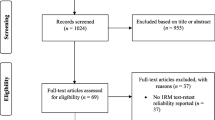Abstract
We investigated muscle strength, aerobic power, and occupational and leisure-time physical loading as predictors of back pain in a 5-year follow-up study. A cohort of 456 adults aged 25, 35, 45 and 55 years, free of back pain, participated in measurements of anthropometric characteristics, aerobic power and muscle strength characteristics at baseline. The subjects' levels and types of physical activity and occupational physical loading were also determined. At 5 years after the baseline examinations 356 of these subjects (78.1 %) were reached by mail, and 262 of them (73.6%) properly completed and returned a questionnaire including a detailed back pain history for the 5 years following the baseline measurements. Of this number 56 subjects (21 %) who reported back pain ( > 30 on a scale from 0 to 100) and functional impairment during the 5-year follow-up composed the marked back pain group. Other subjects (n = 71, 27%) noting lesser symptoms were included in the mild back pain group; 135 subjects (52%) reported having had no back pain. The subjects with marked back pain were on average taller than the subjects without back pain, while no such difference was found in body mass. Heavy occupational musculoskeletal loading (P = 0.005) and high general occupational physical demands (P = 0.036) predicted future back pain. Leisuretime physical activity, aerobic power or muscle strength characteristics were not predictive of future back pain.
Similar content being viewed by others
References
Andersen KL, Shephard RJ, Denolin H, Varnauskas E, Masironi R (1971) Fundamentals of exercise testing. World Health Organisation, Genova
Battie MC, Bigos SJ, Fisher LD, Hansson TH, Jones ME, Wortley MD (1989a) Isometric lifting strength as a predictor of industrial back pain reports. Spine 14: 851–856
Battié MC, Bigos SJ, Fisher LD, Hansson TH, Nachemson AL, Spengler DM, Wortley MD, Zeh J (1989b) A prospective study of the role of cardiovascular risk factors and fitness in industrial back pain complaints. Spine 14: 141–147
Biering-Sørensen F (1984) Physical measurements as risk indicators for low-back trouble over a one-year period. Spine 9: 106–118
Biering-Sørensen F, Hilden J (1984) Reproducibility of the history of low-back trouble. Spine 9: 280–286
Bigos SJ, Battie MC (1990) Risk factors: industrial low back pain. In: Weinstein IN, Wiesel SW (eds) The lumbar spine. Saunders, Philadelphia, pp 846–858
Bosco C (1980) Sei und grande athleta. Vediamo cosa dice l'Er-gojump. Pallavolo 5: 34–36
Cady LD, Bischoff DP, O'Connell ER, Thomas PC, Allan JH (1979) Strength and fitness and subsequent back injuries in firefighters. J Occup Med 21: 269–272
Central Statistical Office (1972) Alphabetical list of occupations and classification of social class (in Finnish). Central Statistical Office, Helsinki
Gyntelberg E (1974) One year incidence of low back pain among male residents of Copenhagen aged 40–59. Dan Med Bull 21: 30–36
Hrubec A, Nashbold BS Jr (1975) Epidemiology of lumbar disc lesions in the military in World War II. Am J Epidemiol 102: 336–376
Karvonen MJ, Viitasalo JT, Komi PV, Nummi J, Järvinen T (1980) Back and leg complaints in relation to muscle strength in young men. Scand J Rehabil Med 12: 53–59
Kujala UM, Viljanen T, Taimela S, Viitasalo JT (1994) Physical activity, 458–1O2max, and jumping height in an urban population. Med Sci Sports Exerc 26: 889–895
Leino P (1993) Does leisure time physical activity prevent low back disorders? A prospective study of metal industry employees. Spine 18: 863–871
Leino P, Aro S, Hasan J (1987) Trunk muscle function and low back disorders: a ten-year follow-up study. J Chron Dis 40: 289–296
Mälkiä E (1983) Muscular performance as a determinant of physical ability in Finnish adult population. Social Insurance Institution, Turku
Ready AE, Boreskie SL, Law SA, Russell R (1993) Fitness and lifestyle parameters fail to predict back injuries in nurses. Can J Appl Phys 18: 80–90
Riihimäki H (1991) Low-back pain, its origin and risk indicators. Scand J Work Environ Health 17: 81–90
Seliger V, Bartunek Z (1976) International Biological Programme results of investigations 1968–1974. Mean values of various indices of physical fitness in the investigation of Czechoslovak population aged 12–55 years. CSTV Praha, Prague
Troup JDG, Foreman TK, Baxter CE, Brown D (1987) The perception of back pain and the role of psychophysical tests of lifting capacity. Spine 12: 645–657
Videman T, Sarna S, Battié MC, Koskinen S, Gill K, Paananen H, Gibbons L (1995) The long-term effects of physical loading and exercise lifestyles on back-related symptoms, disability, and spinal pathology among men. Spine 20: 699–709
Viitasalo JT, Komi PV, Karvonen MJ (1977) Physical health and performance capacity and physical activity habits in conscripts in the beginning of service at Air Force Communications School. University of Jyväskylä, Jyväskylä
Viitasalo JT, Viljanen T, Kujala U (1989) Evaluation of vertical jumping tests. The XII International Congress of Biomechanics. 26–30 June, Los Angeles, USA. Available from the Department of Kinesiology, University of California at Los Angeles, California, USA
Viljanen T, Viitasalo JT, Kujala UM (1991) Strength characteristics of a healthy urban adult population. Eur J Appl Physiol 63: 43–47
Author information
Authors and Affiliations
Rights and permissions
About this article
Cite this article
Kujala, U.M., Taimela, S., Viljanen, T. et al. Physical loading and performance as predictors of back pain in healthy adults A 5-year prospective study. Europ J Appl Physiol 73, 452–458 (1996). https://doi.org/10.1007/BF00334423
Accepted:
Issue Date:
DOI: https://doi.org/10.1007/BF00334423




